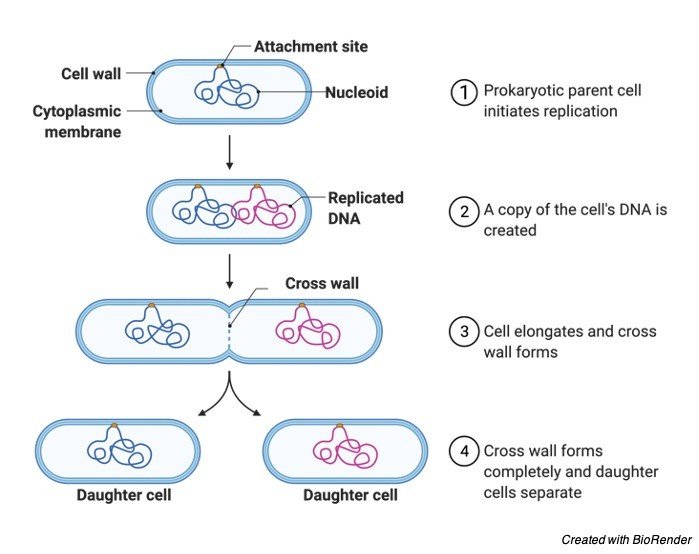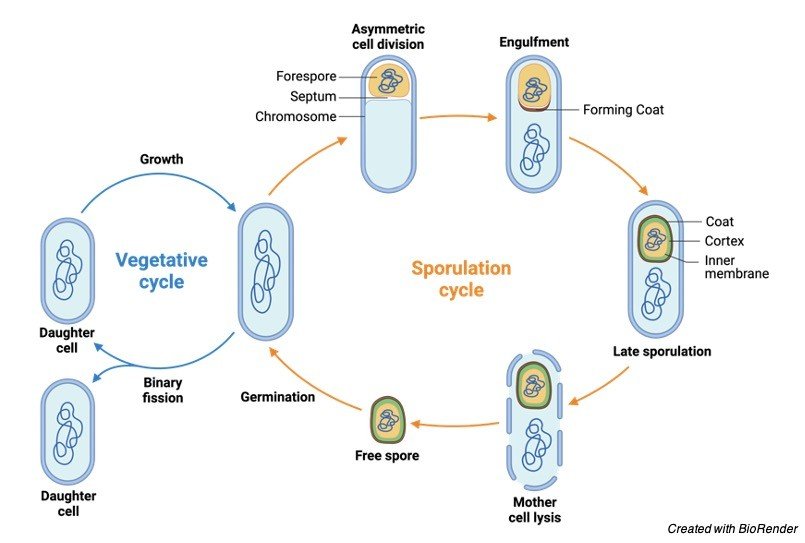Table of Contents
Binary Fission Definition
Binary fission is a kind of asexual reproduction in biology that occurs when a parent cell divides into two identical cells, each with the ability to expand to the size of the original cell.
The term asexual refers to reproduction that takes place without the need for sex cells (gametes). Instead, the somatic cells go through an asexual process that results in a parent clone. Because the offspring’s genome is identical to the parent’s, it is referred to as a clone. Binary fission is quite prevalent among prokaryotes, such as archaea, eubacteria, cyanobacteria, and certain protozoans (e.g. amoeba).
Process of Binary Fission
Prokaryotic cells and certain protozoans reproduce by binary fission. The outcome is an offspring with the same genome as the parent, similar to other mechanisms of asexual reproduction such as budding and the creation of baeocytes (e.g., in the cyanobacterium Stanieria).
Binary Fission in Prokaryotes
Prior to cellular division, the DNA in the prokaryotic cell is tightly coiled. The procedure begins with the creation of a genetic material duplicate. The chromosomes then partition to different poles of the cell, a process known as “karyokinesis.”

The cytoplasm is then split in half by a new cell membrane, which forms (cytokinesis). If the original (parent) cell has one, a cell wall develops as well. The cytoskeleton FtsZ frequently forms a “Z-ring” when the new cell wall develops.

A bacteria undergoing cell fission is seen in the diagram above. The mechanism of bacterial replication looks to be quick and easy, as illustrated. The steps of genomic replication, chromosomal segregation, and cytokinesis in a bacterial cell are as follows: (1) genomic replication, (2) chromosome segregation, and (3) cytokinesis.
Binary Fission in Eukaryotic Cells
Although eukaryotes commonly reproduce sexually, some can also reproduce asexually. Eukaryotes that may reproduce by binary fission include protozoa. One of the primary organelles of eukaryotic cells, mitochondria, divides via binary fission. A prokaryotic fission is comparable to this process. This is one of the foundations of the Endosymbiotic hypothesis, which proposes that basic prokaryotic cells developed into the mitochondria we know today.
Types of Binary Fission
Binary fission may be classified into four kinds based on how the cell divides: irregular, transverse, longitudinal, and oblique.
i. Irregular: The cell splits into any plane in an irregular binary fission. However, it is typically perpendicular to the direction of nuclear division (karyokinesis).
ii. Transverse: Cell division happens along the transverse axis in the transverse-type, thus the name.
iii. Longitudinal: The cell splits lengthwise into longitudinal binary fission.
iv. Oblique: Cell division occurs obliquely in oblique binary fission, which can be left or right oblique.
Binary Fission vs Mitosis
Binary fission is similar to mitosis in that it results in the formation of two identical daughter cells at the end of the process. They do, however, differ in a number of ways.
Mitosis is largely used for growth in multicellular organisms, whereas binary fission is used for reproduction.
Prior to mitosis, the genetic material is duplicated, whereas binary fission occurs during this stage. Spindle fibres are also one of the characteristics that distinguishes mitosis. The spindle fibres connect to the chromosomes and transport them to opposing poles, dividing them into two equal sets.
As in binary fission, the new cells following mitosis will not be a new person. They will transform into a somatic cell that will either differentiate into a specialised differentiated cell or divide mitotically to produce a new set of cells.
Binary fission is a process that occurs in a variety of species. Bacteria, for example, employ it as a method of reproduction. Bacterial fission includes chromosomal replication, chromosomal segregation, and cell splitting, as previously stated. Protozoa are another category of creatures that reproduce through binary fission.
The process of protozoan fission is comparable because it involves similar essential phases. Protozoa, on the other hand, vary from prokaryotes in that they have mitochondria that must be replicated and split. Their cell division patterns differ. In amoebae, for example, cytokinesis can occur in any plane. As a result, their binary fission is of the irregular kind. Euglena is an example of the longitudinal-type. Ceratium, on the other hand, is a protozoan that undergoes oblique cytokinesis. Paramecium is an example of a protozoan with transverse-type binary fission.
Binary Fission Citations
Share












